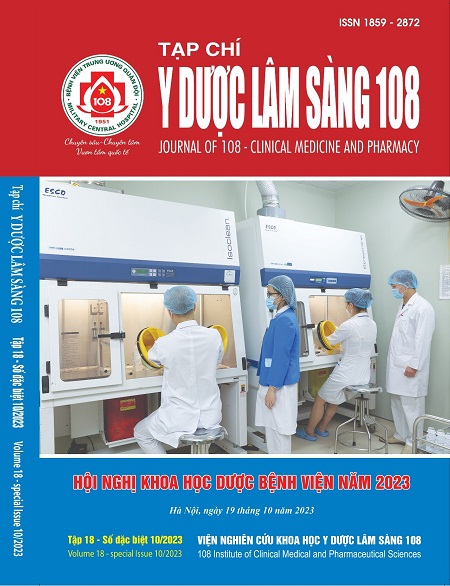Study on consumption of fosfomycin antibiotic at 108 Military Central Hospital from 2020 to 2022
Main Article Content
Keywords
Abstract
Objective: Study on consumption of fosfomycin antibiotic in 108 Military Center Hospital from 2020 to 2022; Orientation for the fosfomycin management program for the hospital. Subject and method: The number of fosfomycin antibiotic was used in clinical departments that belong to the 108 Military Center Hospital from 2020 to 2022, statistic on number of patient-days of internal patients. Result: The consumption of fosfomycin antibiotic from 2020 to 2022 was increased and the number DDD/100 patient-days in 2022 increased 1.7 times compared to 2020. Department of airborne infectious diseases and intensive care, ICU and Endocrinology department were the largest consuming units of fosfomycin with DDD/100 patient-days was 3.06, 2.99, 2.81 respectively. The trend of increasing consumption of fosfomycin in the hospital and ICUs, Endocrinology department were not been identified with Mann-Kendall test for hospital S= 129 p=0.08 (>0.05) and for ICU and Endocrinology p>0.05 too. Conclusion: The study has shown an overall image of the consumption of the antibiotic fosfomycin at 108 Military Central Hospital in the period 2020 - 2022, with the consumption in 2022 of the number of DDD doses/100 days of treatment being 1.7 times higher than in 2020. The airborne infectious diseases and Intensive care, ICU and Endocrinology were the units with the largest consumption of fosfomycin in the Hospital, in which the airborne infectious diseases and intensive care the total number of DDD/100 patient-days of treatment in the 3 years 2020 - 2022 was 3.06 , the ICU was 2.99, and the Endocrinology Department is 2.81.
Article Details
References
2. Falagas ME, Vouloumanou EK, Samonis G, Vardakas KZ (2016) Fosfomycin. Clin Microbiol Rev 29(2): 321-347.
3. Grabein B, Graninger W, Rodríguez Baño J, Dinh A, Liesenfeld DB (2017) Intravenous fosfomycin-back to the future. Systematic review and meta-analysis of the clinical literature. Clin Microbiol Infect 23(6): 363-372.
4. Guclu E, Ogutlu A, Karabay O, Demirdal T, Erayman I, Hosoglu S, Turhan V, Erol S, Oztoprak N, Batirel A, Altay FA, Kaya G, Karahocagil M, Sozen H, Yildirim M, Kocak F, Teker B (2017) Antibiotic consumption in Turkish hospitals; a multi-centre point prevalence study. J Chemother 29(1): 19-24.
5. Hội đồng Thuốc và Điều trị Bệnh viện Trung ương Quân đội 108 (2022) Báo cáo tình hình đề kháng kháng sinh của các vi khuẩn thường gặp tại Bệnh viện.
6. Theuretzbacher U, Van Bambeke F, Cantón R, Giske CG, Mouton JW, Nation RL, Paul M, Turnidge JD, Kahlmeter G (2015) Reviving old antibiotics. J Antimicrob Chemother 70(8): 2177-2181.
7. Đặng Thị Lan Anh, Nguyễn Hoàng Anh B, Nguyễn Thị Mai Anh, Lê Thị Thanh Nga, Nguyễn Thị Thanh Thủy, Đào Quang Minh, Võ Thị Thu Thủy, Nguyễn Hoàng Anh (2019) Đánh giá hiệu quả can thiệp của chương trình quản lý kháng sinh với fosfomycin truyền tĩnh mạch tại Bệnh viện Thanh Nhàn. Tạp chí Dược học. 517, tr. 14-18.
8. WHO (2023) WHO Model Lists of Essential Medicines. accessed, from https://www.who.int/groups/ expert-committee-on-selection-and-use-of-essential-medicines/essential-medicines-lists.
9. WHO (2017) WHO Collaborating Center for Drug Statistics Methology.
 ISSN: 1859 - 2872
ISSN: 1859 - 2872
